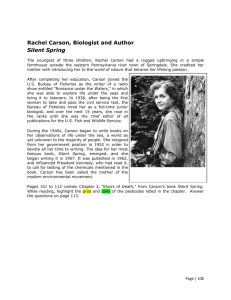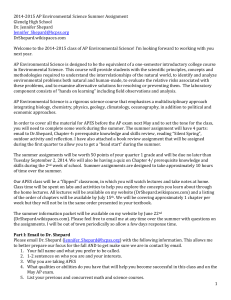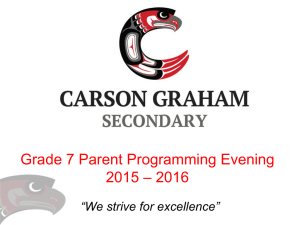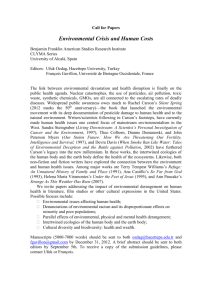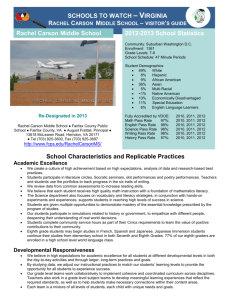APsummerletter2015 - Dr. Shepard's Science Home
advertisement
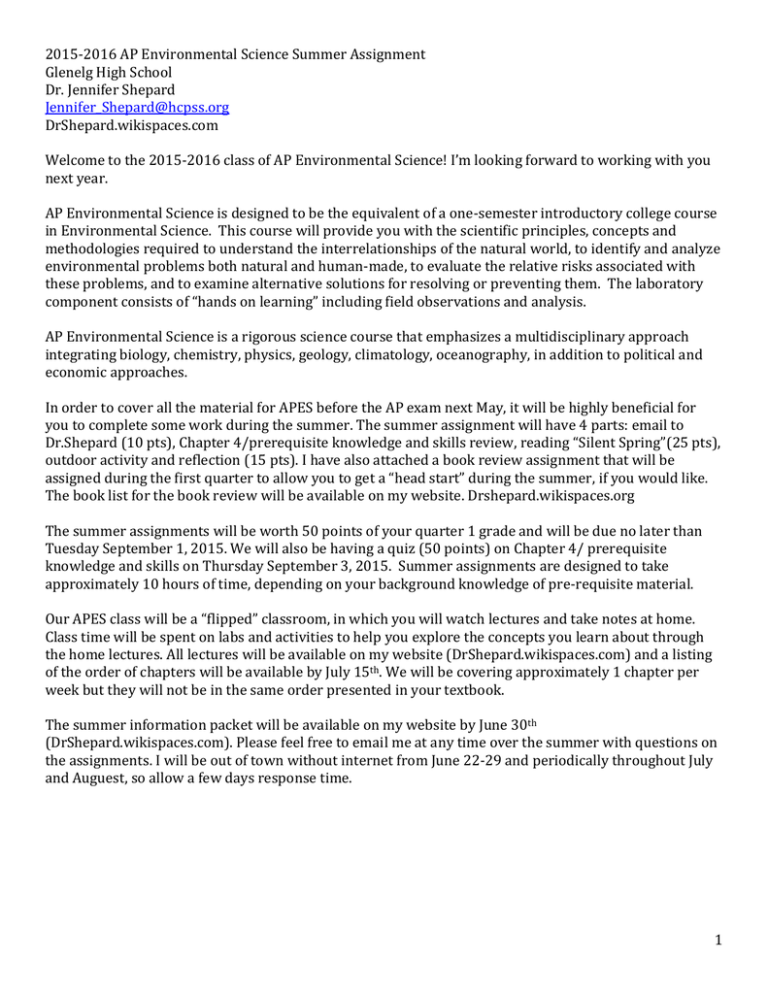
2015-2016 AP Environmental Science Summer Assignment Glenelg High School Dr. Jennifer Shepard Jennifer_Shepard@hcpss.org DrShepard.wikispaces.com Welcome to the 2015-2016 class of AP Environmental Science! I’m looking forward to working with you next year. AP Environmental Science is designed to be the equivalent of a one-semester introductory college course in Environmental Science. This course will provide you with the scientific principles, concepts and methodologies required to understand the interrelationships of the natural world, to identify and analyze environmental problems both natural and human-made, to evaluate the relative risks associated with these problems, and to examine alternative solutions for resolving or preventing them. The laboratory component consists of “hands on learning” including field observations and analysis. AP Environmental Science is a rigorous science course that emphasizes a multidisciplinary approach integrating biology, chemistry, physics, geology, climatology, oceanography, in addition to political and economic approaches. In order to cover all the material for APES before the AP exam next May, it will be highly beneficial for you to complete some work during the summer. The summer assignment will have 4 parts: email to Dr.Shepard (10 pts), Chapter 4/prerequisite knowledge and skills review, reading “Silent Spring”(25 pts), outdoor activity and reflection (15 pts). I have also attached a book review assignment that will be assigned during the first quarter to allow you to get a “head start” during the summer, if you would like. The book list for the book review will be available on my website. Drshepard.wikispaces.org The summer assignments will be worth 50 points of your quarter 1 grade and will be due no later than Tuesday September 1, 2015. We will also be having a quiz (50 points) on Chapter 4/ prerequisite knowledge and skills on Thursday September 3, 2015. Summer assignments are designed to take approximately 10 hours of time, depending on your background knowledge of pre-requisite material. Our APES class will be a “flipped” classroom, in which you will watch lectures and take notes at home. Class time will be spent on labs and activities to help you explore the concepts you learn about through the home lectures. All lectures will be available on my website (DrShepard.wikispaces.com) and a listing of the order of chapters will be available by July 15th. We will be covering approximately 1 chapter per week but they will not be in the same order presented in your textbook. The summer information packet will be available on my website by June 30th (DrShepard.wikispaces.com). Please feel free to email me at any time over the summer with questions on the assignments. I will be out of town without internet from June 22-29 and periodically throughout July and Auguest, so allow a few days response time. 1 Part I: Email to Dr. Shepard Please email Dr. Shepard (Jennifer_Shepard@hcpss.org) with the following information. This allows me to better prepare our focus for the fall AND to get make sure we are in contact by email. 1. Your full name and what you prefer to be called. 2. 1-2 sentences on who you are and your interests or passions. 3. Why you are taking APES 4. What qualities or abilities do you have that will help you become successful in this class and on the May AP exam. 5. List your math, science and any other AP or GT courses you will be taking along with APES next year. 6. What are your college/career aspirations? 7. Answer the following 3 questions with a sentence or 2 each. a. How am I connected to the Earth and other living things? b. What is my purpose and/or responsibility as a human being on this planet? c. What is the role of nature? Part 2: You are expected to enter the course with a good understanding of basic scientific and mathematical concepts and skills as well as strong reading, writing and speaking abilities. Although we will continue to develop these skills throughout the year, your success in the class is also dependent upon what you bring to it at the onset. Over the summer, review the scientific concepts and mathematical calculations in the attached document (Many of which can be found in Chapter 4 of your textbook and the links provided). We will be building upon and referencing them throughout the year. You should be prepared to take a quiz on these skills and concepts during the second week of school. Part 3: Read “Silent Spring” by Rachel Carson and answer discussion questions. “Rachel Carson’s Silent Spring was first published in three serialized excerpts in the New Yorker in June of 1962. The book appeared in September of that year and the outcry that followed its publication forced the banning of DDT and spurred revolutionary changes in the laws affecting our air, land, and water. Carson’s passionate concern for the future of our planet reverberated powerfully throughout the world, and her eloquent book was instrumental in launching the environmental movement. It is without question one of the landmark books of the twentieth century.” (Amazon.com description, 2014) - Discussion Questions can be found at the end of the document. Part 4: Having an appreciation for the outdoors will help you understand the importance of this course. I would like you to spend 2 hours (or more) camping, hiking, canoeing/kayaking, visiting a state or national park, volunteering for an environmental group or learning center. Provide documentation of your visit (i.e., a photo of you taken during the activity, or a signed letter from a supervisor on-site with his or her phone number). Write a one-page reflection (12 point font, double spaced) of your visit, including any observations of wildlife, environmental problems (pollution, etc.), and how you enjoyed the activity. Book Review 1 (Due at the end of Quarter 1): You will be required to write a 650 word summary and reflection of the book you read during the first quarter of 2013. If you feel that it would benefit you to do this during the summer, please see the reading list, that can be found on my website (DrShepard.wikispaces.com), for a list of books that you may choose from. 2 Prerequisite knowledge and skills You are expected to enter the course with a good understanding of basic scientific and mathematical concepts and skills as well as strong, reading, writing and speaking abilities. Although we will continue to develop these skills throughout the year, your success in the class is also dependent upon what you bring to it at the onset. Over the summer, review the scientific concepts and mathematical calculations below. We will be building upon and referencing them throughout the year. You should be prepared to take a quiz on these skills and concepts during the first week of school. Chapter 4 in your textbook covers many of these topics. • there is 1 typo in your textbook. The equation for photosynthesis is wrong, below is correct • 6CO2 + 6H2O + Energy --> C6H12O6 + 6O2 Prerequisite Basic Scientific Concepts: You should be familiar with the following terms/concepts from Biology, Chemistry, and Earth Science: Organic vs. Inorganic Aerobic vs. Anaerobic Natural vs. Synthetic Adaptation Kinetic vs. Potential Energy Mutation Radioactive decay Gene Trait Half life Chromosome Law of Conservation of Matter Gene pool 1st Law of Thermodynamics Natural Selection 2nd Law of Thermodynamics Biodiversity Entropy Extinction Organism Plate Tectonics (causes of volcanoes and Species earthquakes) Contrast Population, Community and Ecosystem Causes of weathering /erosion Producers/Autotrophs Climate Change Consumers/Heterotrophs Rock cycle Decomposers Climate vs. Weather Photosynthesis (reactants and products) pH Cellular Respiration (reactants and products) Some online resources for review: http://earthguide.ucsd.edu/eoc/teachers/t_tectonics/p_map_plate_layers_bath.html https://www.learner.org/interactives/dynamicearth/plate.html https://www.learner.org/interactives/dynamicearth/slip.html http://www.biomanbio.com/GamesandLabs/PhotoRespgames/photoresp.html http://www.epa.gov/acidrain/measure/ph.html 3 https://www.nde-ed.org/EducationResources/HighSchool/Radiography/radioactivedecay.htm http://www.coolmath.com/algebra/17-exponentials-logarithms/13-radioactive-decay-decibel-levels-01 The full name of each of these chemical abbreviations: CO2, CO, C6H12O6, CH4, H2, H2O, N2, NOX, NO3-, NH3, 02, 03, P, P043-, S, S02, Cl, K, NaCl, Pb, Hg, Rn, U CO 2 Carbon dioxide CO Carbon monoxide C 6H 12 O 6 Glucose (product of photosynthesis) CH 4 Methane (greenhouse gas produced by livestock and decomposition) H2 Hydrogen (2 hydrogen atoms bound is how hydrogen is found in the atmosphere, greenhouse gas) H2O Water N2 Nitrogen (2 Nitrogen atoms bound is how nitrogen is found in the atmosphere, can not be used by organisms in this form) NO X Nitrogen oxides (generic form to show NO and NO2 formed from combustion especially in cars) NO 3 - Polyatomic ion, is negatively charged, produced and used as fertilizers NH 3 Ammonia (important for terrestrial organisms, used as fertilizer or precursor to fertilizer and pharmaceuticals) 02 Oxygen (2 atoms bound is how oxygen is found in the atmosphere, this is the only form that organisms can use for respiration) 03 Ozone (3 oxygen atoms bound, important in absorbing UV radiation in the stratosphere, dangerous for humans and other organisms in the troposphere because it binds to hemoglobin but can not be used in respiration) P Phosphorus (elemental phosphorous is how it is found in rocks, not soluble in water and not available for use in living organisms in this form) P0 4 3- Phosphate (polyatomic ion important fertilizer, soluble in water) S Sulfur (elemental sulfur, mineral, needed for life, found in many rocks and fossil fuels) S0 2 Sulfur dioxide (form from the combustion of sulfur containing fossil fuels, combines with hydrogen from water to form sulfuric acid) Cl Chlorine (elemental chlorine is very reactive forms ionic compounds like salt, in upper atmosphere have led to decrease in ozone, in high concentrations toxic to all living organisms) K Potassium (necessary for life, very reactive, soluble in water, used in fertilizers) NaCl Sodium chloride/Table Salt (most commonly found ionic compound of chlorine) Pb Lead (elemental lead, soft/malleable heavy metal, neurotoxin) Hg Mercury (elemental mercury, heavy metal liquid at room temperature, neurotoxin) Rn Radon (elemental radon, radioactive gas at room temperature, a product of the radioactive decay of uranium, considered a health hazard because of radioactivity) U Uranium (elemental uranium, radioactive, used for its nuclear properties/nuclear reactors) 4 Prerequisite Basic Mathematical Skills Percentage 17% = 17/100 = .17 - Remember that "percent" literally means divided by 100. - Percentage is a measure of the part of the whole. Or part divided by whole. -15 million is what percentage of the US population? 15 million / 300 million = .05 = 5% - What is 20% of this $15 bill so that I can give a good tip? $15 x .20 = $15 x 20/100 = $3 Rates Rise Run Y2-Y1 X2-X1 slope change time y=mx+b dX dt - All of the above are ways to look at rates. The second equation is the easiest way to calculate a rate, especially from looking at a graph. Rates will often be written using the word "per" followed by a unit of time, such as cases per year, grams per minute or mile per hour. The word per means to divide, so miles per gallon is actually the number miles driven divided by one gallon. - Rates are calculating how much an amount changes in a given amount of time. Scientific Notation Thousand = 103 =1,000 Million = 106 =1,000,000 (people in the US) Billion = 109 =1,000,000,000 (people on Earth) Trillion = 1012 =1,000,000,000,000 (National debt) - When using very large numbers, scientific method is often easiest to manipulate. For example, the US population is 300 million people or 300xl06or 3xl08 - When adding or subtracting, exponents must be the same. Add the numbers in front of the ten and keep the exponent the same. - When multiplying or dividing, multiply or divide the number in front of the ten and add the exponents if multiplying or subtract the exponents if dividing Ex. 9xl06/ 3xl02 = (9/3) x 10(6-2) = 3 x 104 Dimensional Analysis You should be able to convert any unit into any other unit accurately if given the conversion factor. Online tutorials are available: http://www.chemprofessor.com/dimension_text.htm http://www.chem.tamu.edu/class/fyp/mathrev/mr-da.html 5 Prefixes m (milli) c (cent) k (kilo) M (mega) G (giga) T (tera) =1/1000 =1/100 =1000 =1,000,000 =1,000,000,000 =1,000,000,000,000 =10-3 = 10'-2 =103 =106 =109 =1012 Sample Math Problems Be sure you are able to complete the following types of problems. 1) What is one million times one thousand? Show your work in scientific notation. Give the answer in scientific notation and in words. 2) A population of deer had 200 individuals. If the population grows by 15% in one year, how many deer will there be the next year? 3) One year I had 40 AP Environmental Science students and the next year I had 50 Environmental Science students, what percentage did the population of APES students grow by? 4) Electricity costs 6 cents per kilowatt hour. In one month one home uses one megawatt hour of electricity. How much will the electric bill be? (be sure to look at the prefixes chart on the previous page for the conversion of kilo to mega) 5) Your car gets 15 miles to the gallon and your friend's car gets 25 miles to the gallon. You decide to go on a road trip to Virginia Tech, which is 300 miles away. If gas costs $4 per gallon and you decide to split the gas money, how much money will you save in gas by driving your friend's car? 6) Virginia Beach is 10 miles wide and 30 miles long. If one inch of rain falls on Virginia Beach, how many cubic feet of rain fell on Virginia Beach. (Hint: convert all units to feet first). 6 7) An MP3 takes up about 16 kilobytes of memory per second of music. If you owned a one terabyte hard drive and filled it with only mp3s, how many days worth of music would you have? (keep track of units: kilobytes to terabytes and seconds to days) Reading and Discussion Questions, Rachel Carson, Silent Spring (Ellen Herman, 2014) 1. Carson’s first chapter explains the title of her book. Why is it called “Silent Spring”? 2. Why does she suggest that chemical insecticides and herbicides be called “biocides”? What idea is she expressing by using this word? Is Carson opposed to the use of all toxins? 3. What is uniquely problematic about DDT and other chlorinated hydrocarbons? 4. How do toxins contribute to water pollution? 5. “In nature nothing exists alone” (p. 51). Why is this an important part of Carson’s critique? How would you characterize her view of the many relationships in nature: between human beings and their environments, between plants and animals, between water and earth? 6. What alternatives does Carson propose to the use of chemicals to control unwanted pests and plants? Do you think these alternatives make sense in the context of agribusiness? 7. Her description of chemical spraying suggests that moral dilemmas are involved in the use of toxins as well as technical problems of environmental management. What moral dilemma is Carson worried about? Do you share her view? 8. Carson’s discussion of Dutch Elm disease leads her to advocate “the conservation of variety.” What does she mean by this? 7 9. Why is runoff in rivers and the ocean such a serious problem? 10. What lessons does Carson extract from the stories about spraying for the gypsy moth and the fire ant? What was the role of local activists? Of government officials? Of the chemical industry? 11. Carson describes the kitchen and the garden as poisoned places. What particular implications do these observations have for women? Do you think Carson was aware of these? 12. What is Carson referring to when she writes that there is a “human price” for the use of toxins? Why is it so crucial that human beings begin to see themselves as an essential part of the natural world? Why did she believe that people resisted thinking about themselves in those terms? 13. Carson invokes the term “ecology” (p. 189) to describe “the web of life–or death...” What role does this concept play in her analysis? 14. Carson describes the possibility of genetic damange by environmental hazards as something new. She also discusses cellular damage caused by environmental carcinogens, an especially poignant example because Carson herself died of breast cancer. Do you think of these as novel, even controversial theories? Why or why not? 15. Carson defines the balance of nature at the beginning of chapter 15 on p. 246. Read her definition and explain its major features in your own words. 16. Do you agree that the project of controlling nature is arrogant, foolish, and dangerous, as Carson argues? Why or why not? 17. After reading Silent Spring, how would you characterize its author? Is she a science writer? An environmental activist? A philosopher? 8 During each quarter you will be required to choose a book from the reading list. You will read the book and write a review of the text using the following rubric. The reading list can be found on my website (DrShepard.wikispaces.org). If you find a book that you feel is relevant to environmental science, but it is not found on the list, please submit the title and author for approval by Dr. Shepard. This information is provided for you, in case you want to begin a quarter one book during the summer. The due date for the book review is 4 days before the end of the quarter (100 points). BOOK REVIEW RUBRIC OUTSTANDING EXCELLENT NEEDS IMPROVEMENT UNSATISFACTORY SCORE SUMMARY Summary consists of a discussion of major themes, ideas, and characters providing at least 4 excerpts from the work. It combines ideas from the book into new sentences using your own words. Summary consists of a discussion of major themes, ideas, and characters, providing at least 3 excerpts from the work. It combines ideas from the book into new sentences using your own words. Summary consists of a discussion of major themes, ideas and characters providing at least 2 excerpts from the work. It combines ideas from the book into new sentences using your own words. Summary is mostly an outline of the book and does not discuss themes or major ideas of the work. There may be one direct quote "thrown in" for effect. All direct quotes from the novel are noted by citing page numbers in parenthesis. e.g. (48) (no more than 5) 2 or 3 direct quotes from the novel are noted by citing page numbers in parenthesis. Quotes overused 1 or 2 direct quotes from the novel are noted by citing page numbers in parenthesis. e.g. (48) The summary contains direct quotes without any citation of page numbers. Student provides a detailed discussion of the author’s qualifications. Sources were examined in detail and the student determined whether or not they were appropriate for the work. Student provides a limited discussion Student provides little discussion of The discussion of author and sources of the author’s qualifications. Sources the author’s qualifications. Sources is vague or missing and lacks detail. are examined in a limited manner, and may or may not be briefly examined. the analysis may be limited. Critique consists of thoughts, responses and reaction to the novel. The student reviewer reacts to the themes, the author's aims or intent, the subject of the book, how well it is written and overall success or failure of the book. Critique consists of thoughts, responses and reaction to the novel. The student reviewer may discuss only two aspects, for example, themes and writer's style. There is not a thorough review of various aspects. Critique consists of thoughts, responses and reaction to the novel. The student may discuss only one aspect of the novel, such as themes. This review just states, 'Well, I liked it." or 'Well, I hated it." It lacks a critical eye. Critique consists of a basic opinion based on personal feeling of "I liked it" or "I hated it" and is not considered a critique because it does not focus on themes, author's intent, or writer's style. ORGANIZATION Structure of the paper flows and is easily read because of smooth transitions from paragraph to 10pts paragraph. The sequence of topics is in logical order. There is a clear cut Structure of the paper flows and is easily read, but 1 or 2 transitions may be faulty or missing. There is some illogical order in sequence of topics. There is a clear cut introduction, body Structure of the paper does NOT follow a logical order. The writing or ideas may "jump" around; it is not cohesive. there is not a clear introduction, or conclusion. Structure of the paper does NOT follow a logical order. There are no transitional phrases that make it easy to read the paper...OR... review is just a copying of 10 pts QUOTES 10 pts AUTHOR & SOURCES 20 pts CRITIQUE 20 pts 9 introduction, body, and conclusion. and conclusion. Uses complete sentences and a variety of sentence types. Uses complete sentences and a variety of sentence types. There are 1-2 incomplete sentences or fragments. There are also run-on sentences. There are more than 2 incomplete sentences or fragments. There are more than 2 run-ons. SPELLING 10 pts 0-2 spelling errors 3-5 spelling errors 6-8 spelling errors Over 9 spelling errors FORMAT 10 pts 0-2 formatting errors 3-5 formatting errors 6-8 formatting errors Over 9 formatting errors MECHANICS 10 pts the original book. 10

